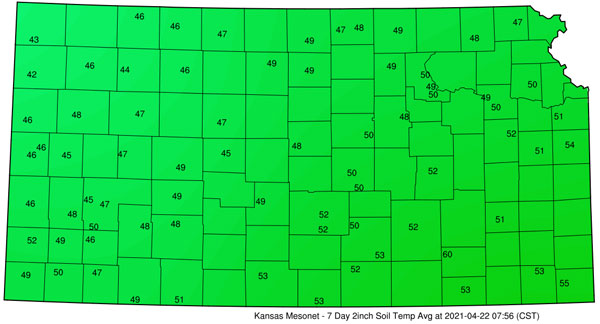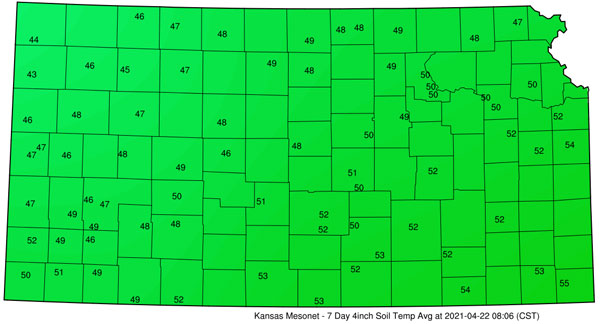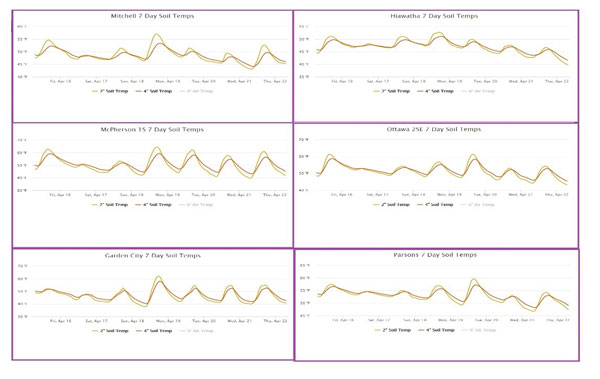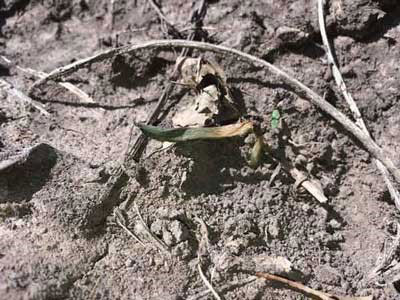Selection of the optimal planting date is one of the most critical factors in the decision-making process for producers. In making this decision, producers should consider soil temperatures rather than just calendar dates. Soils have been slow to warm this year, due to the wetter-than-normal conditions in March, as well as the cooler-than-normal temperatures that have lingered into April.
For this week (April 16-22), the average soil temperature at 2 inches ranged from 42°F in northwest Kansas to 55°F in the southeast. Temperatures at the 4-inch depth are not much different. Weekly average soil temperatures at the 4-inch depth ranged from 43°F in the northwest to 56°F in southeast Kansas (Figure 1).


Figure 1. Average soil temperatures at 2-inch (upper panel) and 4-inch (lower panel) soil depth for the week of April 16 - 22, 2021.
Daily soil temperature variation within the last week (7-day report) was recorded across Kansas for several locations (Figure 2), presenting variations around 20°F. The warming pattern has been uneven across the state. In the west, temperatures have remained fairly steady following a quick cool down mid-week. In the east, there has been a slight decline. Soil temperatures were at 60°F by Monday, April 19, in several locations, before dropping to 45°F or less on Thursday, April 22 (Figure 2).

Figure 2. 7-day soil temperatures (2- and 4-inch soil depth) for Mitchell, Hiawatha, McPherson, Ottawa, Garden City, and Parson (top left to bottom right). 2-inch depth represented by yellow line; 4-inch depth represented by orange line. Graphs produced by the Kansas Mesonet.
Chilling Injury to seeds
Cold temperatures can result in injury to the germinating seed as it is absorbing moisture – a problem called imbibitional chilling injury. Damage to germinating seeds can occur when soil temperatures remain at or below 50 degrees F after planting.
Soil temperatures at the 4-inch depth during the first 24-72 hours after planting are critical. It is during this window that the kernels imbibe water and begin the germination process. Kernels naturally swell when hydrating – taking in water. If the cell tissues of the kernel are too cold, they become less elastic and may rupture during the swelling process, resulting in “leaky” cells. Injury symptoms may include swollen kernels that fail to germinate or aborted growth of the radicle and/or coleoptile after germination has begun.
Chilling injury can also occur following germination as the seedlings enter the emergence process. Chilling injury to seedlings can result in:
- Reduced plant metabolism and vigor, potentially causing stunting or death of the seminal roots
- Deformed elongation (“corkscrewing”) of the mesocotyl
- Leaf burn (Figure 3)
- Delayed or complete failure of emergence, often leafing out underground
Chilled seedlings may also be more sensitive to herbicides and seedling blights.
Before making any decisions, fields should be scouted 4-7 days after the cold occurred as the extent of the damage and potential for new growth will be evident during this time.

Figure 3. Leaf burn from freeze damage early after corn emergence. Photo by Ignacio Ciampitti, K-State Research and Extension.
Producers should consider all these factors when deciding on the planting time. More information about the planting status of summer row crops will be provided in upcoming issues of the Agronomy eUpdate. Stay tuned!
Ignacio Ciampitti, Farming Systems
ciampitti@ksu.edu
Mary Knapp, Weather Data Library
mknapp@ksu.edu